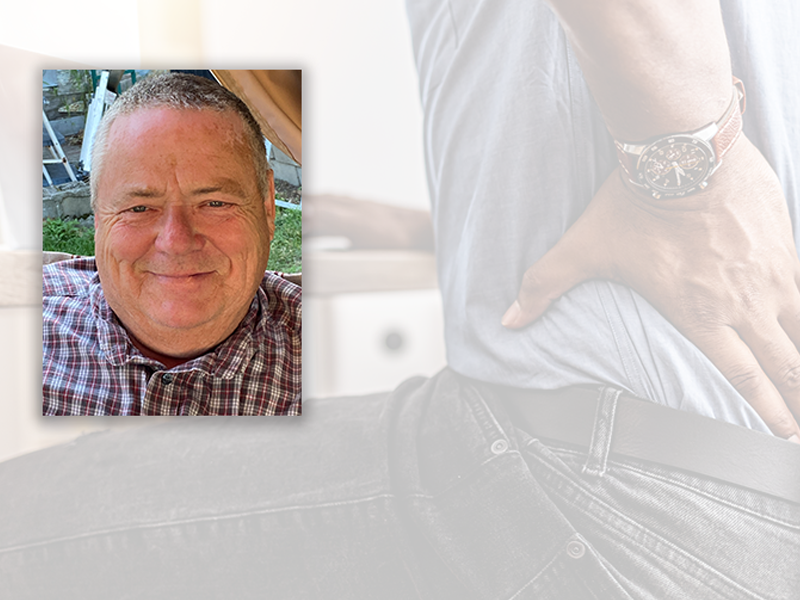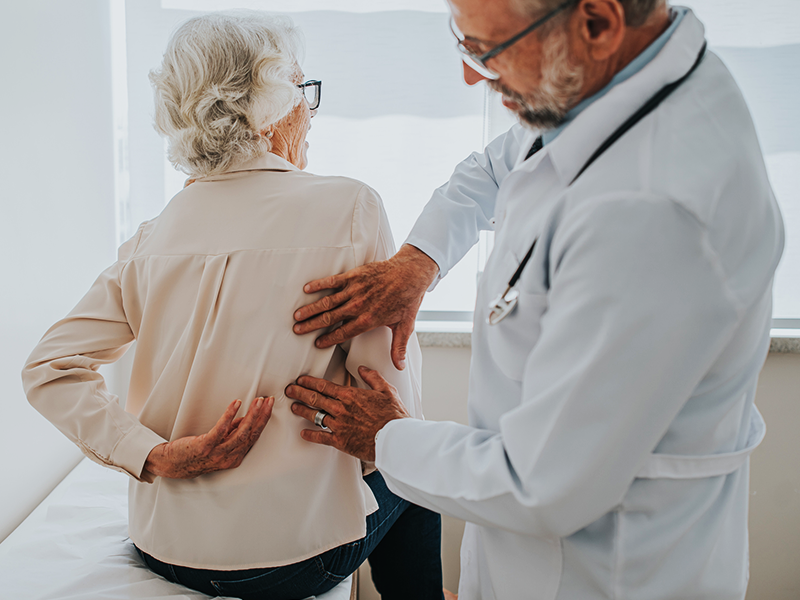Chronic pain affects every aspect of a person’s life and requires a comprehensive approach. The Pain Center at CMC helps people find relief so they can feel more like themselves again. To get you back to a lifestyle you can enjoy, we explore a range of treatment options that leverage many different resources. To be successful in finding relief from pain, patients must be committed and open minded. For some, it is a challenging journey. Our goal is to work with you to precisely diagnose and treat the underlying causes of your pain and find the right treatment so you can get back to a lifestyle you enjoy.
How do we treat our patients?
1. A thorough history and clinical examination
2. Review of previous imaging and interventions
3. Develop a treatment plan
4. Precisely target the pain causes utilizing the most advanced interventional pain management options
Common types of pain treated:
- Back and lower extremity pain
- Cervicogenic headache
- Chronic pelvic and genital pain
- Complex regional pain syndrome (CRPS)
- Epidural scarring after back surgery
- Fibromyalgia
- Joint pain related to osteoarthritis
- Myofascial pain (muscular pain)
- Neck and upper extremity pain
- Neuropathy pain
- Occipital neuralgia
- Pain due to disc herniation, spinal stenosis or facet joint disease
- Pain from degenerative disc disease
- Painful surgical scars
- Post-laminectomy (failed back) syndrome
- Sacroiliac joint pain
- Tailbone pain (Coccygodynia)
- Thoracic pain
- Vertebral compression fractures
Pain can be described in a variety of ways, including:
- Aching or soreness
- Bloating or cramping
- Burning
- Constant
- Comes and goes
- Cutting
- Dull
- Numbing
- Pressing
- Pulling
- Radiating or searing
- Sharp, shooting, or stabbing
- Throbbing
- Tightness
Making an appointment
Your provider must refer you to the Pain Center. Once we receive a referral from your provider, we'll contact you and send you a welcome packet to complete and bring to your initial assessment.
Why choose CMC?
Our team of specialists includes physicians and nurse practitioners with advanced training in treating pain. CMC's Pain Center team is dedicated to developing an individual pain plan for you to help discover the root cause of your chronic pain, reduce suffering and improve your overall quality of life. In assessing causes and solutions for your pain, we will evaluate the medical, physical, emotional, social and behavioral effects on your life. For some patients, this may mean a “new normal” that includes modifications for a chronic condition. You may be able to lead a much more rich and rewarding life than one that is restricted by pain.
Safe & Effective Treatment Options
At CMC’s Pain Center, we draw from a range of traditional and nontraditional treatment therapies to treat your pain. Pain management is about looking at the whole person and how pain is affecting your entire life. We focus on providing a blend of non-invasive treatment options coupled with behavioral and physical therapy. Common treatment options include:
Acupuncture is a form of traditional Chinese medicine involves the insertion of very thin needles through the skin at specific points on the body, known as acupuncture points or acupoints. These points are believed to correspond to different organs and bodily functions. Acupuncture is widely recognized for its effectiveness in treating various types of pain, including:
- Chronic pain, such as back pain, neck pain, and osteoarthritis
- Migraines and tension headaches
- Menstrual cramps
- Dental pain
- Postoperative pain
Spinal discography: This is a minimally invasive spinal procedure intended to diagnose spinal discogenic pain. A needle is inserted into the nucleus of the target disc, x-ray contrast injected inside, images are taken, and the patient’s response to increasing the pressure inside the disc is evaluated and recorded. Tears, cracks, herniation, and degeneration of the discs can be seen with more accuracy and the patient’s pressure response is obtained.
VIA Disc Procedure: This is a percutaneous minimally invasive disc procedure intended to relieve pain from disc degeneration. The procedure is done by injecting nucleus pulposus allograft to replace the disc material lost from disc degeneration.
Other percutaneous disc procedures for discogenic pain include:
- Intradiscal Biacuplasty (IDB): This is a minimally invasive percutaneous spinal procedure for pain resulting from disc degeneration. In this procedure, two electrodes are placed, one from each side, inside the target disc and radiofrequency waves flow between them. The generated heat, applied to the outer layer of the disc (annulus), ablates the tiny nerves that carry pain sensation from the disc.
- Intradiscal Electrothermal Therapy procedure (IDET): This is a minimally invasive percutaneous spinal procedure for pain from disc degeneration. Heat is applied to the outer layer of the disc (annulus) using a special catheter placed inside the disc to thicken and strengthen the disc wall and to ablate the tiny nerves that carry pain sensation from the disc
A DRG neurostimulation system is composed of two parts:
- Stimulation leads: These are thin wires placed in the epidural space to stimulate the dorsal root ganglia of the nerves controlling the painful area.
- Pulse generator: A small device implanted under the skin and connected to the stimulation leads to provide electrical stimulation.
- Trial of stimulation: Temporary stimulating trial lead(s) are placed in the epidural space using X-ray guidance in an outpatient procedure. The patient is sent home with an external stimulator to try the stimulation for few days then the leads are taken out.
- Permanent Implantation: If the stimulation is successful in relieving the patient’s pain, new permanent leads and an internal pulse generator are implanted in an outpatient surgical procedure.
Epidural steroid injections are common spinal injections utilized for pain management. In this injection, a steroid medication is injected precisely using x-ray guidance into the epidural space of the level causing the symptoms. The epidural space is located just outside the spinal sac throughout the whole spine from the neck down to the tailbone region. These injections are commonly used to treat radiculopathies and/or spinal stenosis at the different spinal levels. Radiculopathies are painful conditions caused by pinched or irritated spinal nerve root(s) producing radiating and shooting pain and/or numbness to the extremities , in case of the cervical and lumbar spine ,or to the front of the abdominal or chest wall, in case of the thoracic spine. Spinal stenosis is a condition where there is narrowing of the main spinal canal or one of its foramina where nerve roots exit the spine. Epidural injections are usually done under local anesthesia and patients go home shortly after the procedure.
Epidural injections are named according to the targeted spinal level as follow:
- Cervical epidural steroid injection ( in the neck)
- Thoracic epidural steroid injection (In the upper and mid-back)
- Lumbar epidural steroid injection ( In the lower back)
- Caudal epidural steroid injection ( lowest part of epidural space above the tailbone)
Epidural injections are also named according to the place where the needle enters the epidural space as follows:
- Interlaminar epidural (entry is from midline in between the spines of the spine.)
- Transforaminal epidural (entry is from the foramen where the nerve root exit the spine.)
- Medial branch blocks: This is done by numbing the nerves that take the feeling of pain from these joints (medial branches) two blocks are done to confirm that the target facets are the definite source of pain.
- Radiofrequency ablation of the medial branches: If both of the two medial branch blocks are successful in relieving the patient’s pain, ablation or burning of these nerves (Radiofrequency ablation) can be done. This treatment provides a longer lasting pain relief.
- Trigger point injections: These are used to treat localized areas of painful muscle spasms called trigger points. It involves needling and Injection of the painful trigger points in the affected muscles of the body. The Piriformis and Psoas muscles are usually done under X-ray or ultrasound guidance.
- Peripheral joint steroid injections (and /or Hyaluronidase gel for knee): These are used to treat joint pains. Examples include, knee, hip, shoulder, acromioclavicular, ankle, wrist, symphysis pubis, and small joints of the hands and feet.
- Bursa Injections: These are used to treat pain from inflamed bursa or the fluid sacs present in the body near muscles and tendons. Examples include trochanteric bursa, iliopsoas bursa, sub acromial bursa, Pes anserine bursa, Knee bursa, Olecranon or elbow bursa, and Hamstring or ischial bursa.
- Tendon sheath Injections: These are used to treat pain from inflamed tendons. Injection is precisely done around the inflamed tendon. Examples include: Biceps tendon in the shoulder, and Achilles tendon in the heel
- Tendon Insertion Injections: These are used to treat pain from inflamed tendon insertions. Examples include injection of Tennis elbow (lateral epicondylitis) and Golfer’s elbow (medial epicondylitis).
- Fascia and ligament injections: These are used to treat pain from inflamed ligaments or fascia. Examples include Plantar fasciitis and sacrococcygeal ligament
Treatment techniques include:
- Myofascial Release
- Articulatory Technique
- Strain/Counterstrain
- Active Isolated Stretch Technique
- Cold Spray and Stretch Technique
- Ligamentous Balance
- Muscle Energy Release
- Soft Tissue Release
- Craniosacral Technique
- Progressive Inhibition of Neuromuscular Structures
- Neurokinetic Therapy
Acupuncture needles have long been utilized in therapeutic treatment. Acupuncture can stimulate blood flow, endogenous pain neurotransmitters and a healing cascade. Effective treatments typically provides relief for several weeks.
During this treatment, the patient is positioned laying face down on an exam table. Treatment time can vary from 15 minutes to 45 minutes. Risks are low, including discomfort with application of sterile acupuncture needles and treatment, temporary local skin reaction, and ineffectiveness of treatment. Limitations on number of treatments may vary by insurance.
The PENS modality can be a therapeutic treatment option for people who want to avoid pain medications and/or wean off pain medications.
Radiofrequency ablate the nerve branches that transmit the feeling of pain of the treated joint. Pain relief usually last between six months to one year and can be repeated if needed. A successful diagnostic block is usually needed before these procedures are scheduled. Examples include:
- Radiofrequency ablation of the genicular nerves: done for knee joint ablation
- Radiofrequency ablation of the articular branches of the femoral and obturator nerves: done for hip joint ablation.
- Radiofrequency ablation of the articular branches of the suprascapular, axillary nerve, and lateral pectoral nerves for shoulder joint ablation.
Examples include:
- Anterior cutaneous nerve block
- Brachial plexus block
- Carpal tunnel block
- Femoral nerve block
- Genitofemoral nerve block
- Ilioinguinal nerve block
- Intercostal nerve block
- Lateral femoral cutaneous nerve block
- Lumbar plexus block
- Morton’s neuroma injection
- Obturator nerve block
- Occipital nerve block
- Peroneal nerve block
- Pudendal nerve block
- Saphenous nerve block
- Sciatic nerve block
- Superficial radial nerve block
- Supraorbital nerve block
- Suprascapular nerve block
- Sural nerve block
- Tarsal tunnel block
- Tibial nerve block
A peripheral nerve stimulation system is composed of two parts:
- Stimulation leads: These are thin wires placed next to the target peripheral nerve.
- Pulse generator: A small device that provides electrical stimulation. At CMC's Pain Center, we use the “Curonix Freedom System” of peripheral nerve stimulation. This advanced system has a non-implantable pulse generator that works wirelessly to stimulate a small implanted stimulation lead.
- Trial of stimulation: Temporary stimulating trial lead is placed and the patient is sent home with an external stimulator to try the stimulation for few days then the lead is taken out.
- Permanent Implantation: If the stimulation is successful in relieving the patient’s pain, new permanent leads are implanted in an outpatient surgical procedure.
- Suprascapular nerve for chronic shoulder pain
- Infrapatellar saphenous nerve for chronic knee pain
- Tibial nerve for chronic foot and ankle pain
- Cluneal nerves for chronic buttock and low back pain
- Occipital nerve stimulation for occipital neuralgia
- Sacroiliac joint steroid injection: Injection of sacroiliac joints with local anesthetic and steroids serves to diagnose and treat sacroiliitis. Injection is done precisely under X-ray guidance and the patient goes home shortly after the procedure.
- Sacroiliac joint Radiofrequency ablation: If the diagnosis of sacroiliitis is established but the steroid injections provide very short term pain relief, radiofrequency ablation or burning of the small nerves that innervate the sacroiliac joint is a treatment option with potential longer term of pain relief. The procedure is done precisely using small needles, under x-ray guidance, with local anesthesia, and the patient goes home shortly after the procedure.
- Sacroiliac joint Stabilization/Fusion: This is a minimally invasive procedure that is done for patients with proved diagnosis of Sacroiliitis but their pain does not respond adequately to steroid injections. We utilize a simple and safer posterior approach to the joint using the “LinQ procedure”. The procedure is done precisely using under x-ray guidance, with local anesthesia, and IV sedation and the patient goes home few hours after the procedure.
A spinal cord stimulation system is composed of two parts:
- Stimulation leads: These are thin wires placed in the epidural space to stimulate the spinal cord.
- Pulse generator: A small device implanted under the skin and connected to the stimulation leads to provide electrical stimulation.
- Trial of stimulation: Temporary stimulating trial lead(s) are placed in the epidural space using X-ray guidance in an outpatient procedure. The patient is sent home with an external stimulator to try the stimulation for few days then the leads are taken out.
- Permanent Implantation: If the stimulation is successful in relieving the patient’s pain, new permanent leads and an internal pulse generator are implanted in an outpatient surgical procedure.
Examples of sympathetic nerve blocks include:
- Sphenopalatine ganglion Block for migraines and head pain
- Stellate ganglion block for head and upper extremity pain.
- Lumbar sympathetic block for lower extremity pain.
- Celiac plexus block for upper abdominal visceral pain.
- Superior hypogastric plexus block for pelvic pain.
- Ganglion Impar block for rectal and tailbone pain.



